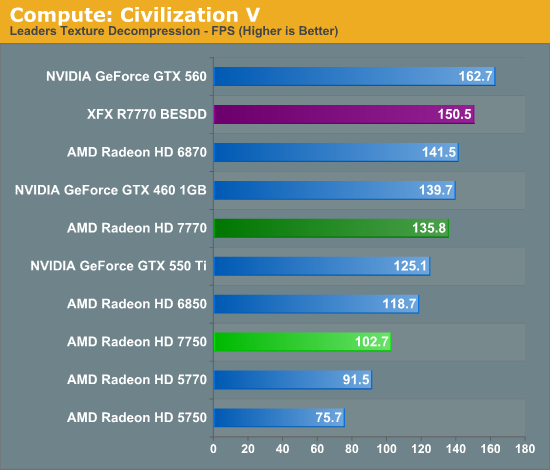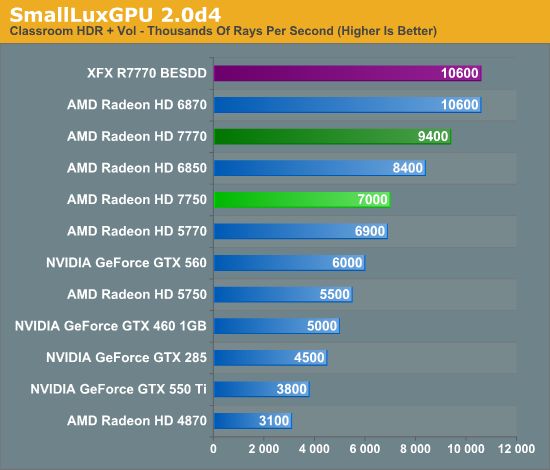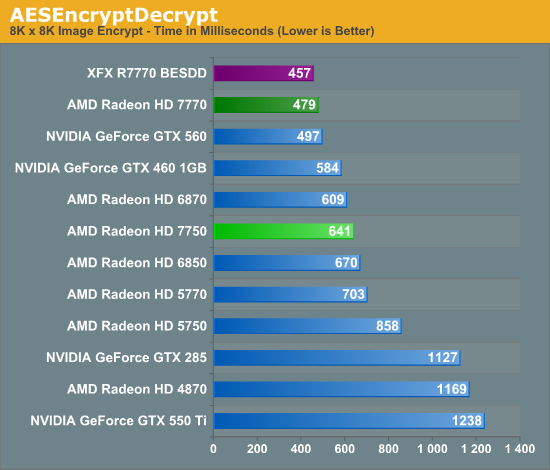AMD Radeon HD 7750 & Radeon HD 7770 GHz Edition Review: Evading The Price/Performance Curve
by Ryan Smith & Ganesh T S on February 15, 2012 12:01 AM EST- Posted in
- GPUs
- AMD
- HTPC
- GCN
- Radeon HD 7000
Compute Performance
Moving on from our look at gaming performance, we have our customary look at compute performance. With GCN AMD significantly overhauled their architecture in order to improve compute performance, as their long-run initiatives rely on GPU compute performance becoming far more important than it is today.
With such a move however AMD has to solve the chicken and the egg problem on their own, in this case by improving compute performance before there are really a large variety of applications ready to take advantage of it. As we’ll see AMD has certainly achieved that goal, but it raises the question of what was the tradeoff for that? We have some evidence that GCN is more efficient than VLIW5 on a per-shader basis even in games, but at the same time we can’t forget that AMD has gone from 800 SPs to 640 SPs in the move from Juniper to Cape Verde, in spite of a full node jump in fabrication technology. In the long run AMD will be better off, but I suspect we’re looking at that tradeoff today with the 7700 series.
Our first compute benchmark comes from Civilization V, which uses DirectCompute to decompress textures on the fly. Civ V includes a sub-benchmark that exclusively tests the speed of their texture decompression algorithm by repeatedly decompressing the textures required for one of the game’s leader scenes. Note that this is a DX11 DirectCompute benchmark.

Theoretically the 5770 has a 5% compute performance advantage over the 7770. In practice the 5770 doesn’t stand a chance. Even the much, much slower 7750 is ahead by 12%, meanwhile the 7770 is in a class of its own, competing with the likes of the 6870. The 7770 series still trails the GTX 560 to some degree, but once again we’re looking at the proof of just how much the GCN architecture has improved AMD’s compute performance.
Our next benchmark is SmallLuxGPU, the GPU ray tracing branch of the open source LuxRender renderer. We’re now using a development build from the version 2.0 branch, and we’ve moved on to a more complex scene that hopefully will provide a greater challenge to our GPUs.

SmallLuxGPU is another good showing for the GCN based 7700 series, with the 7770 once again moving well up the charts. This time it’s between the 6850 and 6870, and well, well ahead of the GTX 560 or any other NVIDIA video cards. Throwing in an overclock pushes things even farther, leading to the XFX BESDD tying the 6870 in this benchmark.
For our next benchmark we’re looking at AESEncryptDecrypt, an OpenCL AES encryption routine that AES encrypts/decrypts an 8K x 8K pixel square image file. The results of this benchmark are the average time to encrypt the image over a number of iterations of the AES cypher.

Under our AESEncryptDecrypt benchmark the 7770 does even better yet, this time taking the #2 spot and only losing to its overclocked self. PCIe 3.0 helps here, but as we’ve seen with the 7900 series there’s no replacement for a good compute architecture.
Finally, our last benchmark is once again looking at compute shader performance, this time through the Fluid simulation sample in the DirectX SDK. This program simulates the motion and interactions of a 16k particle fluid using a compute shader, with a choice of several different algorithms. In this case we’re using an (O)n^2 nearest neighbor method that is optimized by using shared memory to cache data.

It would appear we’ve saved the best for last, as in our fluid simulation benchmark the top three cards are all 7700 series cards. This benchmark strongly favors a well organized cache, leading to the 7700 series blowing past the 6800 series and never looking back. Even NVIDIA’s Fermi based video cards can’t keep up.










155 Comments
View All Comments
ArizonaSteve - Wednesday, February 15, 2012 - link
Time for the DOJ to start looking into the price fixing that's going on here.A5 - Wednesday, February 15, 2012 - link
Price fixing is explicit, purposeful collusion between 2+ manufacturers to set prices at an unnaturally high level. For an example, see the memory market in the early 2000s.That is not what is happening here.
mattgmann - Wednesday, February 15, 2012 - link
Both of these companies settled price fixing lawsuits in 2008 under similar circumstances. They've cheated before; don't be surprised if they're cheating again.mckirkus - Wednesday, February 15, 2012 - link
If Coke and Pepsi both start pricing cans of soda at $50 each, doesn't mean people will buy them. The 7770 is a $50 can of soda.CeriseCogburn - Wednesday, March 21, 2012 - link
Yeah sure is price fixing when the always victorious gtx460 is $110 bucks and beats the 7770 every time and there's a large stock available...Or the other, triple fan GTX580 at the egg for $359, and the other reduced way down from $500.
AMD is scalping we customers even now and has been since before this review.
chizow - Wednesday, February 15, 2012 - link
There's an easy solution to price fixing: Don't buy at their asking price, or buy the faster, last-gen for cheaper.Its not like GPUs go bad like produce or get consumed like oil. Just keep using whatever you have in your rig now, because chances are its just as fast at a cheaper price than what AMD is asking for these "new" next-gen parts.
Iketh - Thursday, February 16, 2012 - link
meh I'm not worried about it just yet, it's too early... I bet it's because of poor yields, which would make the pricing legitimate... remember it's a new arch on a new nodeif the situation is the same in a month or 2, i'll be among those complaining
akbo - Wednesday, February 15, 2012 - link
I guess AMD is gonna let go of the old 6850 quick, 'cause no one is gonna buy it with this prices. Perf/watt very good tho, although mem bandwith very dissapointing. DDR4 is not coming soon enough, let alone GDDR6. 128 bits are simply not enough and 256 bits is adding more power/complexity. Can't wait for the day when GDDR6 comes and hopefully doubles bandwith for lower power/efficient clock speed. Oh, and gpu companies, when that day comes, don't be stingy like you always are and end up giving us 64 bits instead.silverblue - Wednesday, February 15, 2012 - link
Bring back TBDR and you won't need stupidly wide memory buses. ;)Roland00Address - Wednesday, February 15, 2012 - link
This is figuring out the price per performance, how many dollars you have to spend to get each FPS. Using Anandtech's Crysis: Warhead: 1680x1050 Gamer Quality Everything, Enthusiast Shaders+4xAA (Lower is better since you get a better bang for your buck.) Prices are from Newegg, using the cheapest card out there, no MIR are factored in, price includes shipping. Notes the 7750 and 7770 are not on newegg yet, so I am using the MSRP with no shipping to figure out the FPS per dollar. The GTX460 is using an older anandtech test since it is no longer using the more recent benchFPS Per Dollar/Video Card/FPS/Price/Shipping/Total
$3.81 Radeon 5750 28.1 99.99 6.98 106.97
$3.23 Radeon 5770 32.5 104.99 0.00 104.99
$3.23 Radeon 6850 45.7 139.99 7.56 147.55
3.01 Radeon 6870 53.1 159.99 0.00 159.99
3.46 Radeon 7750 31.8 109.99 0.00 109.99
4.35 Radeon 7770 36.8 159.99 0.00 159.99
3.88 Geforce GTX550 TI 32.7 119.99 6.98 126.97
3.56 Geforce GTX460 1GB 41.4 139.99 7.56 147.55
3.65 Geforce GTX560 48.5 169.99 6.98 176.97
As you can see, the Radeon 7750 is actually a very good card for its price. It beats the old Radeon 5770 series, and all the Geforce only losing to the Radeon 6800 series in the terms of value. Don't forget though the Radeon 7750 can be single slot, doesn't need a 6 pin, and generates less noise and heat.
The 7770 on the other hand is the most expensive card in the terms of value. Notice that Geforce cards have a higher dollar per fps (they have less value), for the Radeon card to succeed it only has to compete with Geforce since Radeon still makes money if you buy one of the other Radeon cards. If the 7770 was priced at 131.01 it would have identical value as the gtx460 1gb, and 142.78 if the card was priced against the value of the GTX550 TI.
I wouldn't be surprised that the Radeon 7770 will drop to the 139.99 or 149.99 price range once all the older 5700 series and 6800 series leave the channel. I do not think we are going to see much cheaper 7750s though since it is a recycled part and its price per performance is very good already. OEMs are going to be eating up the 7750s like candy.